Abstract
The interest of the research community in happiness and its associated issues has been steadily growing over the years, including during the period marked by the COVID-19 pandemic. The pandemic has brought about significant changes in various aspects of people’s lives. In this study, the objective is to analyze the themes and the most significant trends in papers dedicated to happiness in the context of COVID-19 during the period following the onset of the pandemic. To achieve this, the authors have compiled a dataset of papers sourced from Clarivate Analytics’ Web of Science Core Collection database, which were extracted using keywords related to both happiness and COVID-19. This database comprises 1932 articles. The researchers have conducted a comprehensive bibliometric analysis of this dataset, providing insights into the most prolific authors in this field, the most frequently cited documents, and the preferred journals for publishing this research. The authors also explore details related to collaboration networks and author clusters. An n-gram analysis is performed on titles, abstracts, keywords, and keywords plus, offering a deeper understanding of the primary research themes. Furthermore, the contributors present a review of the top 10 most cited papers, which completes the analysis and underscores the research trends related to happiness in the context of COVID-19.
1. Introduction
What is happiness, and how can we measure happiness?
Researchers across disciplines like psychology, philosophy, and neuroscience have investigated happiness and sought to comprehend its essence, though defining and examining this subjective concept poses challenges [1]. Happiness has been studied since ancient times. Aristotle stated that there are four levels of happiness. The lowest level of happiness is determined by material possessions, and this happiness is short-lived. The second level is achieved when people make comparisons, comparing themselves to others or evaluating their situation in relation to others. For example, when an individual wins a competition or attains a title, their happiness is determined in relation to the situation of those they competed against for a particular position. The third level is reached when we help others or contribute to positive changes in society. The fourth and highest level, from Aristotle’s perspective, is reached when a person creates a spiritual connection and approaches perfection [2]. In the last four decades, scientists such as Diener [3], Kahnemann [4], and Veenhoven [5] have made significant strides in developing conceptual frameworks for happiness and well-being, along with measurement scales across various disciplines, notably psychology, economics, and sociology.
Surveys are one of the most used methods for happiness measurement among researchers. Over the years, scientists have developed widely known surveys such as the Oxford Happiness Questionnaire (OHQ) [6], the World Values Survey (WVS) [7], the European Quality of Life Surveys (EQLS) [8,9], the European Social Survey (ESS) [10], and the Gallup World Poll (GWP) [11,12,13,14].
Countries like Australia, Canada, New Zealand, and the United Kingdom, as well as those in the European region, have begun to contemplate the pursuit of citizens’ “happiness” as a national objective [6,15]. The results of the study conducted by Salameh in Pakistan shows that well-being is enhanced by factors such as income, education, government effectiveness, the absence of perceived corruption, and the perceived quality of institutions [15].
The importance of happiness and well-being in people’s lives has also been recognized by the United Nations (UN) [16], which considers well-being a crucial attribute that contributes to social and economic development. The UN has urged member states to adopt additional measures that better capture the pursuit of happiness and well-being in development strategies and policies. It has also been observed that there is a linkage between happiness and sustainability; it is considered that sustainable development positively impacts individuals’ well-being and contributes to a higher quality of life [17,18,19]. In 2015, the UN provided the 2030 Agenda for Sustainable Development, which includes 17 Sustainable Development Goals (SDGs). Among these 17 goals, the UN highlighted the importance of well-being by considering the third goal: “good health and well-being” [20].
The 2020 World Happiness Report is the eighth report published, and this edition explores the relationship between Sustainable Development Goals (SDGs) and well-being in chapter two, called “Social Environments for World Happiness”. The World Happiness Report was published for the first time in 2012, and it is a collaborative work involving the Oxford Wellbeing Research Center, Gallup, and the UN Sustainable Development Solutions [21]. The results present a high and significant correlation between the SDG Index and subjective well-being (SWB), with a correlation coefficient equal to 0.79 [22]. This strong positive relationship underscores the importance of adopting a comprehensive approach to economic development when aiming to enhance the well-being of citizens. The best-fitting model describing the relationship between the SDG Index and SWB takes a quadratic form [22]. This suggests that at higher levels of the SDG Index, a stronger positive correlation exists between the index score and SWB. This finding implies that economic growth plays a crucial role in driving well-being during the early stages of development, but its significance diminishes as countries progress further in their development cycle.
In the paper written by O’Brien, “Happiness and Sustainability Together at Last! Sustainable Happiness” [23], the authors propose a new concept called “sustainable happiness”, which defines this concept as “happiness that contributes to individual, community and/or global well-being without exploiting other people, the environment or future generations”. The concept of sustainable happiness is presented as an opportunity to enhance our overall quality of life while simultaneously contributing to individual, community, and global well-being [23]. By acknowledging this new concept and its implications, individuals can consider it in a manner that is mindful of its long-term impact on the environment and future generations when achieving their happiness.
The correlation between well-being and sustainability has also been acknowledged since 2006, when Nic Marks created the Happy Planet Index (HPI) [24], which was housed by the New Economics Foundation (NEF) between 2006 and 2019. Currently, the HPI is housed by the Wellbeing Economy Alliance (WEAll), which has developed a user-friendly platform that allows individuals to explore their findings and calculate their personal HPI. This index is a survey instrument that assesses well-being and aspects of sustainability and resilience. This index is a resource that offers valuable data to communities, researchers, and policymakers for improving economic equality, environmental sustainability, community well-being, and individual happiness. HPI includes various domains such as education, time balance, social support, health, environment, work, and material well-being.
On 29 December 2019, in the city of Wuhan, situated in Hubei Province, China, the initial four cases of pneumonia were officially documented through a surveillance mechanism designed for the purpose of investigating “pneumonia of unknown etiology”. This mechanism, initially instituted in 2003 following the outbreak of SARS (Severe Acute Respiratory Syndrome), serves the crucial function of promptly identifying novel pathogens. Notably, a common thread amongst the four cases in Wuhan was their frequent patronage of an open-air live animal market [25].
In order to mitigate the dissemination of the virus and alleviate its strain on healthcare infrastructure, the World Health Organization (WHO) has advocated for a multifaceted approach encompassing early diagnosis, preventive measures, social distancing, heightened adherence to hygiene practices, and the implementation of lockdowns [26].
In response to the SARS-CoV-2 threat, governmental authorities in various nations have instituted measures for social isolation to effectively manage the COVID-19 pandemic within their respective territories [27]. Subsequent investigations have revealed that such restrictions have been associated with adverse psychological effects, including anxiety and depression [28,29,30,31,32], sleep disturbances [33,34,35,36,37], and alterations in physical activity levels [36,38,39].
Amidst the backdrop of the COVID-19 pandemic, there has been a notable surge in scholarly interest pertaining to the investigation of fluctuations in happiness. Researchers have undertaken studies in various regions, including, but not limited to, the United States of America [29,40], China [28,29,30], Italy [29,38,41,42,43], Spain [29,41], Turkey [29,44], Germany [31,45], and the United Kingdom [45].
Survey data collected in Italy by Bimonte et al. [43] indicate that the primary direct impact of the pandemic on respondents’ happiness is associated with the influence of the pandemic and lockdown on interpersonal relationships. Individuals who stated that COVID-19 and lockdown had compromised their interpersonal connections were notably less likely to express higher levels of happiness, particularly when accounting for other personal and contextual factors.
In the study on life satisfaction during the COVID-19 pandemic conducted by Delhey et al. [45] using panel data from the United Kingdom between 2020 and 2021, researchers showed that life satisfaction was found to be evidently connected to human, economic, social, and psychological capital, with the last one standing out as the strongest predictor.
Comprehensive research was conducted by Xiong et al. [29], which implied a systematic search carried out on the following databases: PubMed, Embase, Clarivate Analytics’ Web of Science Core Collection, Medline, and Scopus, and a manual search on Google Scholar covering the period from inception to 17 May 2020. The study considered papers from China, the United States, Turkey, Nepal, Denmark, Spain, Italy, and Iran that reported rates of anxiety symptoms (ranging from 6.33% to 50.9%), depression (14.6% to 48.3%), post-traumatic stress disorder (7% to 53.8%), psychological distress (34.43% to 38%), and stress (8.1% to 81.9%) in the general population.
In this specific context, the primary objective of this paper is to accentuate the scholarly output pertaining to the study of happiness within the framework of the COVID-19 pandemic. Our aim is to delineate the research interests of the scientific community concerning the discussion and measurement of happiness during the COVID-19 pandemic period. To achieve this goal, we intend to elucidate various aspects, including the growth of scientific research, the corpus of documents dedicated to this topic, the authors actively engaged in researching this subject matter, and the sources they have chosen for publication. In order to construct our research corpus, we have meticulously selected the ten most frequently cited papers from the database we extracted, and we have conducted a detailed review of these papers. Furthermore, we have undertaken an n-gram analysis on titles, abstracts, keywords, and keyword combinations to uncover words closely associated with the concept of happiness within the context of the COVID-19 pandemic.
For this research undertaking, a set of indicators has been chosen for assessing happiness. These indicators have been employed to compile a database of scientific papers sourced from Clarivate Analytics’ Web of Science Core Collection platform [46].
The selected indices encompass a range of factors, including subjective well-being, quality of life, the happiness index, gross national happiness, the global happiness report, the national happiness survey, and personal happiness assessment, among others. The decision to incorporate these specific metrics was guided by a comprehensive survey of happiness measurement instruments found in the academic literature [47,48,49,50,51,52].
The subsequent sections of this paper are organized as follows: Section 2 offers a comprehensive presentation of the methodological intricacies associated with the extraction and subsequent analysis of the database, employing a bibliometric approach. Section 3 proceeds to unveil the findings stemming from the bibliometric analysis. This section not only provides an overview of the database that was extracted but also delves into the scrutiny of noteworthy authors, documents, sources, and significant terms. Furthermore, it encompasses an examination of the ten most highly cited papers and a hybrid analysis designed to establish associations between authors, their respective countries, affiliations, utilized keywords, and preferred publishing sources. Section 4 is dedicated to a thorough discussion of the limitations that are inherent in this study’s approach. Finally, in Section 5, the paper reaches its conclusion, summarizing the key insights and findings.
2. Materials and Methods
Bibliometric research offers a distinctive perspective through a reasonably comprehensive analysis [53]. The advantage of bibliometric analysis is that it allows researchers to analyze substantial volumes of historical data derived from research conducted over a specific period, facilitating the retrieval of information from the repository [53]. This analysis is a different approach to systematic literature reviews, which typically employ qualitative techniques and may be susceptible to interpretation bias from scholars with diverse academic backgrounds [54].
Donthu et al. [54] used a four-step methodology for the bibliometric analysis procedure, defining the aims and scope of the bibliometric study, choosing the techniques for bibliometric analysis, collecting the data, running the bibliometric analysis, and reporting the findings, while Marin-Rodriguez et al. [55] and Anac et al. [56] focused mainly on the steps related to data collection, bibliometric analysis, and reporting. As a result, in the following section, we will develop the steps related to dataset extraction and data analysis.
2.1. Dataset Extraction
For importing bibliographic data, several databases are available, including Scopus, Clarivate Analytics’ Web of Science Core Collection (WoS), Dimensions, Cochrane Library, Lens, and PubMed, each possessing distinct properties and functionalities [53]. Currently, the most extensively utilized literature databases across nearly all disciplines are Clarivate Analytics’ Web of Science Core Collection and Scopus [57,58].
As a result, in the present study, we have opted for the Clarivate Analytics’ Web of Science Core Collection platform [46] to retrieve articles related to happiness measurement in the times of COVID-19. The Web of Science Core Collection, which is produced by Clarivate Analytics, consists of ten sub-collections that include eight citation indexes and two chemical indexes. Access to the database’s contents depends on the type of subscription an individual has through their academic institution. The search results on the WoS platform can vary depending on the number of sub-datasets accessible to the user [59]. According to papers [59,60], papers engaged in bibliometric analyses must accurately define and disclose information about the utilized sub-databases.
This research considered all ten indexes offered by WoS, including the following:
- ▪
- Science Citation Index Expanded (SCIE)—1900–present.
- ▪
- Social Sciences Citation Index (SSCI) 1975–present;
- ▪
- Arts & Humanities Citation Index (A&HCI)—1975–present.
- ▪
- Conference Proceedings Citation Index—Social Sciences and Humanities (CPCI-SSH)—1990–present.
- ▪
- Conference Proceedings Citation Index—Science (CPCI-S)—1990–present.
- ▪
- Emerging Sources Citation Index (ESCI) 2005–present.
- ▪
- Book Citation Index—Science (BKCI-S)—2010–present.
- ▪
- Current Chemical Reactions (CCR-Expanded)—2010–present.
- ▪
- Book Citation Index—Social Sciences and Humanities (BKCI-SSH)—2010–present.
- ▪
- Index Chemicus (IC)—2010–present.
The required steps for extracting the papers are described in Table 1.

Table 1.
Data selection steps.
The initial three exploration steps (1–3) were conducted using the Clarivate Analytics’ Web of Science Core Collection (WoS) platform and involved searches within articles that included any of the following terms from the provided list in their titles, abstracts, or keywords: “happiness measurement”, “subjective well-being”, “life satisfaction”, “happiness assessment”, “well-being measurement”, “quality of life assessment”, “happiness scale”, “well-being indicators”, “subjective happiness”, “well-being survey”, “happiness index”, “well-being measurement tools”, “happiness and life evaluation”, “positive psychology measures”, “psychological well-being”, “life quality assessment”, “Gross National Happiness”, “happiness and social indicators”, “societal happiness measurement”, “global happiness measurement”, “global happiness report”, “happiness and public policy”, “well-being economics”, “happiness research methods”, and “personal happiness assessment national happiness surveys”.
This list was manually created by the authors based on their review of several articles where these terms were utilized in the titles, abstracts, or keywords, specifically in the context of research related to happiness during the COVID-19 pandemic and happiness measurement [61,62,63,64,65,66,67].
In addition to supporting the inclusion of specific keywords in our database extraction search, it is worth noting the significance of certain key indices and concepts. One of the most prominent indices is the gross national happiness index (GNH), which was initially formulated in 1972 by the Centre for Bhutan Studies [68,69]. This index serves as a distinctive measure of both economic and moral progress, offering a compelling alternative to conventional economic measures such as gross domestic product (GDP).
Furthermore, the concept of subjective well-being (SWB) is integral to our study, denoting an individual’s cognitive and affective evaluation of their own life [70]. In 1984, Larsen et al. [71] conducted a comprehensive comparative analysis of various subjective well-being scales, including five single-item scales and six multi-item scales. Their research indicated that the scale developed by Fordyce emerged as one of the most effective single-item scales, while multi-item scales demonstrated similar levels of reliability and validity.
The Quality of Life Index (QOLI), introduced by Ed Diener in 1985 [68], serves as a tool for distinguishing between developed countries. It utilizes seven distinct variables, including deforestation, human rights violations, suicide rates, homicide rates, purchasing power, literacy rates, and satisfaction of basic needs. Lastly, the global happiness report, derived from a survey conducted in 30 countries by global advisors, centered on exploring the factors contributing to people’s happiness during the era of the COVID-19 pandemic. This report unveiled that individuals in the Netherlands and Australia predominantly described themselves as either “very” or “rather” happy, with China and the United Kingdom following closely behind in this ranking [72].
As a result of the search performed based on the selected keywords, 19,274 papers were found to contain at least one of the searched words in their title or keywords, and 43,576 papers contained the selected words in their abstracts.
The fourth exploration step involved a merger, as most of the papers contained the chosen keywords in more than one of the three areas (title, abstract, or keywords). The result of the merging was 52,577 papers, but the number of papers decreased to 50,150 in the fifth exploration step based on the language criterion, where only papers written in English were kept in the analysis.
The sixth exploration step limited the documents to articles only, which left 43,229 articles.
The seventh exploration step considerably reduced the number of papers to 2589 due to the criterion of the title, abstract, or keyword containing “COVID-19” or “coronavirus”. This step allowed us to restrict the research to only analyzing papers that study happiness during COVID-19. After applying the last criterion, 1932 papers remained in the analysis, which means that in the first 10 months of 2023, 657 articles were written on this topic. The authors made a deliberate decision to consider data up until 2022 in this bibliometric analysis. This decision was motivated by the desire to maintain the integrity and reliability of the citation indicators provided by Biblioshiny, a bibliometric analysis tool that will be presented in the next subchapter. By limiting the analysis, the authors aimed to minimize biases or inconsistencies in the citation indicators. This approach is a common practice in bibliometric research, whereby researchers often set specific cutoff points for data collection to maintain consistency and comparability across studies.
As a result, 1932 papers have been retained in the database and have been analyzed as presented in the following section.
2.2. Bibliometric Analysis
The analysis of the data involved citation, content, and visualization analysis, and it was performed using bibliometrics. For the generation of visualizations, we utilized Biblioshiny 4.0.0, a web application powered by Bibliometrix R-package 4.3.2 and developed in 2017 by Aria and Cuccurullo [73] at Federico II University and the University of Campania Luigi Vanvitelli. With the significant increase in academic publications in recent years, as highlighted by Aria and Cuccurullo [73], it has become progressively difficult to stay abreast of the constantly expanding body of literature. This has made bibliometric analysis a necessity nowadays. This software was chosen for relevant graphics that demonstrate the links between the factors taken into consideration. However, the program is used for numerous research projects across various research fields [74,75,76,77,78,79].
The methodology employed in the study involves the analysis of three primary types of indicators, which are activity indicators, quality indicators, and relationship indicators. This approach is consistent with the framework outlined by Castillo-Vergara et al. [80]. The inclusion of these indicators allows for a comprehensive assessment of the research, encompassing both quantitative and qualitative aspects of the study. Activity indicators include the number of countries, journals, papers, and authors and are mainly used for productivity measurement [80,81]. Quality indicators refer to the impact factor, H-index, total number of citations, and average article citations per year [80], while relationship indicators deal with co-citations and co-authorship [80,81].
The above-mentioned indicators have been incorporated into the analysis steps, as presented in Table 2.

Table 2.
Bibliometric analysis steps.
3. Dataset Analysis
In the following discussion, we delve into various aspects within the extracted papers related to happiness in the context of the COVID-19 pandemic. These aspects include authors, sources, and citations, which are essential for understanding the landscape of research in this field.
3.1. Dataset Overview
The bibliometric analysis encompassed a comprehensive dataset comprising 1932 articles, sourced from 795 distinct publications, and published between 2020 and 2022. This dataset provides valuable insights into the research landscape surrounding happiness during the COVID-19 pandemic, as evident from the time gap between the onset of the pandemic and the publication of relevant papers (Table 3).

Table 3.
Main information about data.
The citation analysis conducted by Biblioshiny reveals that the average number of citations per document is 16.71, indicating a significant interest among researchers in the literature related to happiness during the pandemic. Furthermore, the data suggest an average of 5.426 citations per year per document, underscoring the growing attention devoted to this topic.
The citation data also highlights that the chosen titles collectively contain a total of 68,307 references, translating to an average of 35.35 references per document. This underscores the extensive scope and depth of the research conducted on happiness during the COVID-19 pandemic.
The number of papers written annually has shown a significant increase, as evident in Figure 1, with a peak of 1000 documents in 2022, representing an impressive annual growth rate of 124.85%. Notably, in the first year of the pandemic period, over 500 articles were published on the subject of happiness during COVID-19. This surge in research output underscores the heightened interest among researchers in examining the impact of the pandemic on happiness, particularly during times of isolation and reduced social interactions.
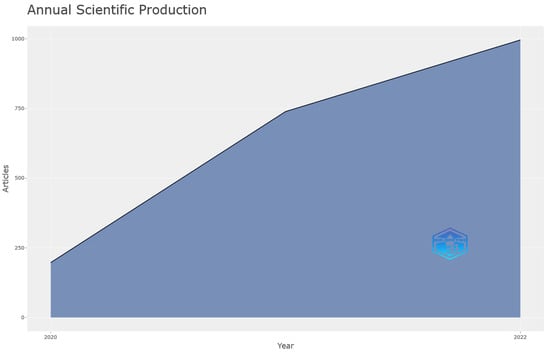
Figure 1.
Annual scientific production evolution.
The average citation per article exhibited a noticeable decline from 25 citations in 2020 to fewer than 5 citations in 2022, reflecting a shift in the research landscape. This change suggests that papers published during the pandemic period enjoyed good visibility and recognition, but there has been a subsequent decrease in the interest of researchers in the study of happiness during COVID-19, as depicted in Figure 2.
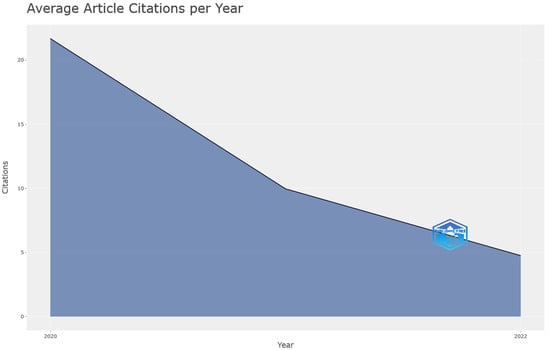
Figure 2.
Annual average article citations per year evolution.
Table 4 reveals that the collective count of keywords, particularly the index terms automatically generated from the titles of referenced articles, reached 2183, averaging 1.13 keywords per document.

Table 4.
Document contents.
Table 5 provides key metrics for evaluating the authors who have contributed to the research on happiness and satisfaction during the COVID-19 pandemic. The analysis reveals a total of 8982 unique authors, who collectively account for 10,257 appearances across the extracted documents. In the bibliometric study conducted by Pang et al. [82] on happiness and satisfaction before and during COVID-19, the results showed that there were 5220 unique authors before COVID-19, between 2014 and 2019, and 3520 unique authors during COVID-19 (2020–2022).

Table 5.
Authors.
The data suggest a strong collaborative network among authors in this field. This is evidenced by the relatively small number of authors associated with single-authored documents (89) compared to the total number of extracted documents (1932). Furthermore, the substantial number of authors involved in multi-authored documents (8893) relative to single-authored documents (89) underscores the prevalence of collaborative research efforts in this domain. Similar results were also presented in the bibliometric analysis conducted by Pang et al. [82], where authors for single-authored documents were 375 and 4845 authors for multi-authored documents during COVID-19.
These findings indicate that the research on happiness and satisfaction during the COVID-19 pandemic has been driven by a large and diverse group of authors who have actively engaged in collaborative work to advance the understanding of this topic.
Table 6 reveals that there are 95 single-authored documents out of 1932. Comparing this number to the count of authors in single-authored documents (95 versus 89), it suggests that authors who publish independently contribute to an average of approximately 1.06 documents each.

Table 6.
Authors’ collaboration.
In the case of the number of authors surpassing the number of selected papers, the indicator for documents per author is 0.22, signifying an average of 4.65 authors per paper. As per Aria and Cuccurullo [83], the authors per document index is calculated by dividing the total number of authors by the total number of articles. Consequently, if an author has contributed to multiple articles, they are counted only once in determining this index. When comparing the authors per document index with the co-authors per document index, it may be speculated that the relatively low value for the authors per document indicator is influenced by numerous authors who have authored multiple papers. For papers with more than two authors, the average number of co-authors per document is 5.31. The collaboration index, obtained by dividing the total number of authors of multi-authored papers (8893 authors) by the total number of multi-authored articles (1837 articles), is 4.84, which falls within the typical range for papers in the field of social sciences (Table 6).
3.2. Sources
Figure 3 presents the top journals with more than 10 articles published on the topic. The International Journal of Environmental Research and Public Health claims the first position with 203 papers. It is an open-access transdisciplinary journal indexed in various databases, including Scopus, PubMed, MEDLINE, PMC, Embase, GEOBASE, CAPlus/SciFinder, and more, with a CiteScore of 5.4. The journal covers a range of disciplines, including Environmental Health, Environmental Sciences, Behavioral and Mental Health, Exercise, and Health-Related Quality of Life. There is a significant difference of 80 papers between the first and second places.
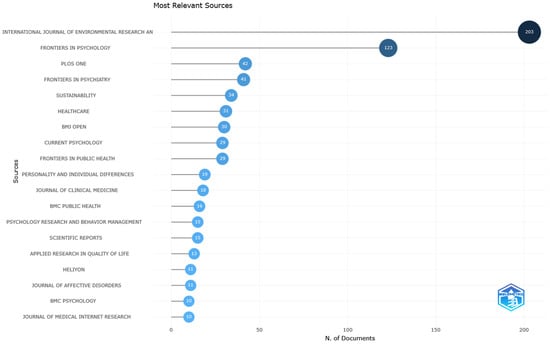
Figure 3.
Top 19 most relevant journals.
Frontiers in Psychology secures second place, consisting of 35 specialty sections such as Health Psychology, Mindfulness, Positive Psychology, and more. This journal boasts an impact score of 3.8 and a CiteScore of 4.5, with over 531,900 citations. The gap between second and third place is also substantial, at 81 papers.
PLOS ONE, an open-access journal with an impact factor of 3.7 that has experienced significant growth since 2019, holds the third position. PLOS ONE is indexed in various databases, including Crossref, Dimensions, DOAJ, Google Scholar, PubMed, PubMed Central, Scopus, and Web of Science.
Below PLOS ONE, the differences in the number of papers are not as significant. The fourth journal, Frontiers in Psychiatry, is separated from the third position by only one paper. Other notable sources related to happiness during COVID-19 between 2020 and 2022 include Sustainability, with 34 papers, Healthcare, with 31 papers, BMJ Open, with 30 papers, Current Psychology and Frontiers in Public Health, both with 29 papers, Personality and Individual Differences, with 19 papers, Journal of Clinical Medicine, with 18 papers, BMC Public Health, with 16 papers, Psychology Research and Behavior Management, and Scientific Reports, each with 15 papers, Applied Research in Quality of Life with 13 papers, Heliyon and Journal of Affective Disorders, each with 11 papers, and BMC Psychology and Journal of Medical Internet Research, each with 10 papers.
Figure 4 illustrates the most relevant journals based on the number of publications, and it is evident that the first two journals concentrate the majority of the articles published on this topic.
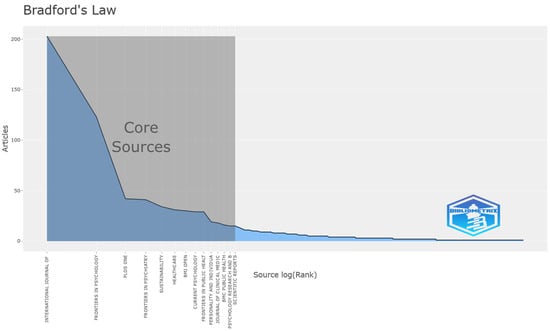
Figure 4.
Bradford’s law on source clustering.
Bradford’s Law of Scattering is a significant concept in bibliometrics. This law establishes a quantitative relationship between journals and the papers they publish. According to Viju et al. [84], Bradford’s Law of Scattering categorizes articles into three distinct zones based on journal productivity. The first zone, called the “nuclear zone”, consists of highly productive journals [84]. The second zone is moderately productive, while the third zone has low productivity [84]. Bradford observed a consistent pattern in the number of titles within each of these zones.
Bradford’s Law suggests that a small number of core journals, typically around one-third, will contribute a significant portion of the articles on a specific topic. The next third is covered by a second group of journals, while the final third is distributed among a larger set of journals.
Interestingly, Bradford did not provide a mathematical foundation for his law initially. Subsequently, researchers such as Brookes, Vickery, and Leimkuhler proposed mathematical models to support his law [84].
In the context of this paper’s analysis, Bradford’s Law of Scattering is applied to 14 sources within Zone 1. These sources include the International Journal of Environmental Research and Public Health, Frontiers in Psychology, PLOS ONE, Frontiers in Psychiatry, Sustainability, Healthcare, BMJ Open, Current Psychology, Frontiers in Public Health, Personality and Individual Differences, Journal of Clinical Medicine, BMC Public Health, Psychology Research and Behavior Management, and Scientific Reports, as illustrated in Figure 4.
Bibliometric analysis relies on various metrics to assess research impact and quality. One such metric is the H-index, introduced by Hirsch in 2005. The H-index considers both the number of papers published and the number of citations received by an author or journal. It has become a common metric in bibliographic databases and is frequently used to evaluate the quality of researchers’ work [85].
It is important to note that no single bibliometric index can perfectly capture the impact and quality of research. Therefore, it is advisable to use multiple metrics and recognize that the field of science continuously evolves, leading to the development of new metrics over time [86].
For the analysis of journals based on the H-index, journals with an H-index value greater than or equal to seven were considered. This led to the inclusion of 16 journals in the analysis. Figure 5 illustrates that Frontiers in Psychology has the highest H-index value, followed by the International Journal of Environmental Research and Public Health. This ranking differs from the one based on the number of papers published.
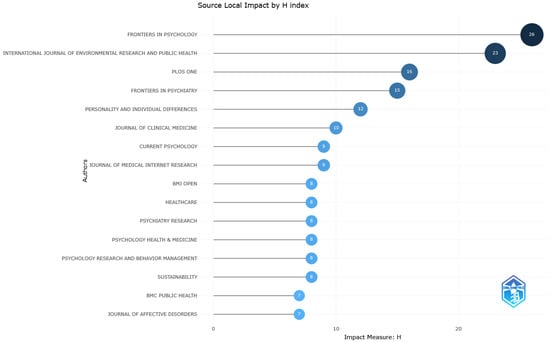
Figure 5.
Journals’ impact based on H-index.
Interestingly, the journals that were part of Zone 1 according to Bradford’s Law of Scattering are also the top journals in terms of H-index in Figure 5. There are some exceptions, such as Psychiatry Research, Psychology, Health & Medicine, and Journal of Affective Disorders, which have H-index values equal to or higher than seven but were not part of Zone 1. Conversely, Frontiers in Public Health, Personality and Individual Differences, and Scientific Reports are in Zone 1 but have H-index values below seven.
Figure 6 provides an overview of the publication years of the most recent papers by the 21 most published authors in the field of social sciences and psychology related to happiness during the COVID-19 pandemic.
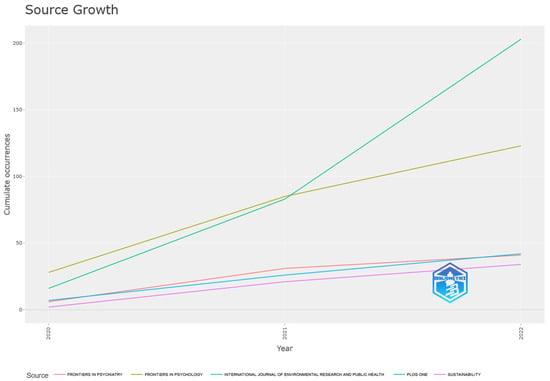
Figure 6.
Journals’ growth (cumulative) based on the number of papers.
Research and Public Health (light green) experienced the most significant increase in the number of published papers. It was followed by Frontiers in Psychology (olive green), Frontiers in Psychiatry (orange), PLOS ONE (blue), and Sustainability (pink), in that order. These changes in publication output reflect the evolving research landscape and the growing interest in the subject of happiness in the context of COVID-19.
3.3. Authors
In the analysis of the most relevant authors in the field of social sciences and psychology related to happiness during COVID-19, a criterion of a minimum of five papers authored by an individual was applied. This resulted in the inclusion of 21 authors in the analysis, and the results are presented in Figure 7.
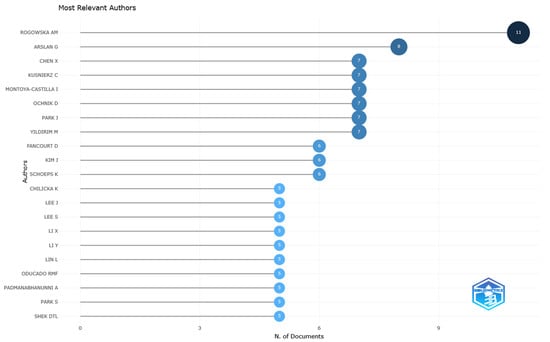
Figure 7.
Top 21 authors based on number of documents.
Among these authors, Rogowska AM. from the University of Opole, Poland, stands out as the top author, having written 11 papers on happiness during COVID-19 between 2020 and 2022. Arslan G. from Mehmet Akif Ersoy University, Turkey, also wrote 11 papers on the same topic during the selected timeframe. Chen X., Kusnierz C., Montoya-Castilla I., Ochnik D., Park J., and Yildirim M. each authored seven articles. Fancourt D., Kim J., and Schoeps K. wrote six articles each, while Chilicka K., Lee J., Lee S., Li X., Li Y., Lin L., Oducado RMF., Padmanabhanunni A., Parks S., and Shek DTL. authored five articles each.
Figure 8 provides an overview of the publication years of the most recent papers by the 21 most published authors in the field of social sciences and psychology related to happiness during the COVID-19 pandemic.
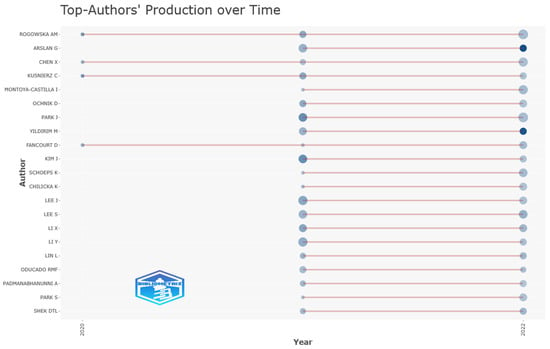
Figure 8.
Top 21 authors’ production over time.
The figure reveals that the majority of these authors produced a substantial number of papers in 2021 and 2022.
Specifically, only four authors—Rogowska AM., Chen X., Kusnierz C., and Fancourt D.—focused on this subject in 2020, which was the first year of the pandemic. In contrast, 11 authors published the majority of their articles in 2022. The remaining authors contributed to an almost even distribution of articles between 2021 and 2022.
Figure 9 illustrates the top 21 affiliations of authors who contributed to the selected papers on happiness during the COVID-19 pandemic. The data reveal a diverse range of affiliations, with several notable universities and institutions from different parts of the world.
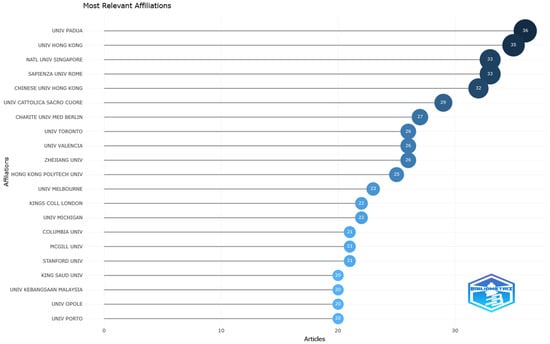
Figure 9.
Top 21 most relevant affiliations.
The University of Padua in Italy ranks as the top affiliation in terms of author contributions, followed closely by the University of Hong Kong, the National University of Singapore, Sapienza University Rome, and the Chinese University of Hong Kong.
This data highlight the global nature of research in this field, with significant contributions from universities in Asia, Italy, and the United States of America, among other regions.
Figure 10 provides insight into the geographical distribution of publications on the topic of happiness during the COVID-19 pandemic. The top contributors to these publications are the United States, China, and Italy, which together account for a substantial portion of the research output in this field.
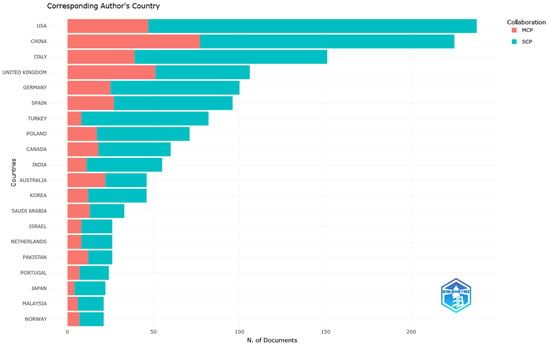
Figure 10.
Top 20 most relevant corresponding author’s country.
Out of the total of 1492 papers analyzed, the USA, China, and Italy published 614 papers, constituting approximately 41.15% of the total. The USA, with 191 single-country publications (SCPs) and 47 multiple-country publications (MCP), demonstrates a significant level of intra-country collaboration. China follows closely with 148 SCP and 77 MCP.
Italy, the United Kingdom, and Germany round out the top five contributors, with 151, 106, and 100 articles, respectively—please see Figure 10.
A global visualization map provides an easy-to-interpret view of each country’s contributions to this research field. Figure 11 illustrates the scientific contributions categorized by the respective countries of the authors of the analyzed papers.
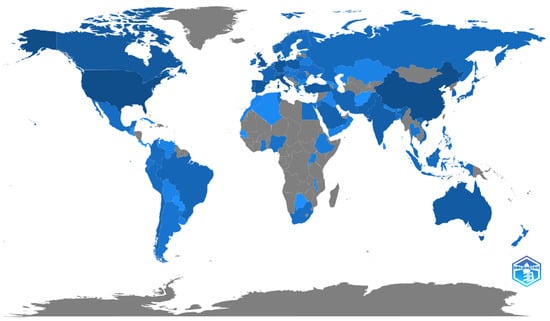
Figure 11.
Scientific production based on country.
The map in Figure 11 employs a grayscale spectrum, ranging from dark blue to represent countries with substantial contributions, such as China, the USA, Italy, Germany, Australia, Spain, the United Kingdom, and Turkey, to lighter shades, including countries like Mongolia, Libya, and Congo. These lighter shades indicate nations where no articles related to happiness during COVID-19 in the fields of social science or psychology were published.
Figure 12 presents the top 20 countries ranked by the highest number of citations for papers authored by researchers affiliated with each country.
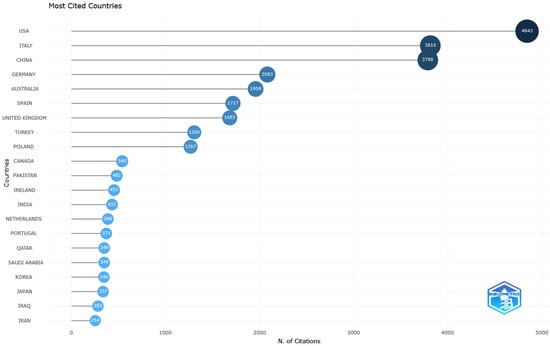
Figure 12.
Top 20 countries with the most citations.
The United States emerges as a leading country in terms of citations across various bibliometric studies on well-being and related topics: in a study analyzing the 100 most cited sedentary behavior articles [87], the United States ranked first in overall most cited articles; a bibliometric analysis of the top 100 most-cited articles in hepatology identified the United States as the most productive country in publishing highly cited articles in the field [88]; a study on positive psychology from 1999 to 2021 found that positive psychology publications in the United States were more influential than those from other countries [89], with American institutions demonstrating significant influence in the field. Over a third of the publications in the field of psychological well-being originated from the United States, showcasing its prominent position in research output and citations [90]. These studies collectively demonstrate the United States’ strong presence in bibliometric analyses related to well-being, sedentary behavior, hepatology, and positive psychology, consistently ranking among the top countries in terms of total citations and citation impact.
Figure 13 depicts the country collaboration map, showcasing collaborative relationships between countries. China has 51 collaborations with the USA, 23 with the United Kingdom, 13 with Australia, and 11 with Canada. The USA, on the other hand, has 24 collaborations with the United Kingdom, 22 with Italy, 21 with Canada, 16 with Germany, and 15 with Australia. The United Kingdom has 21 collaborations with Canada, 17 with Germany, 14 with France, 14 with Turkey, 13 with Australia, and 11 with Spain. This results in nine collaborations with various countries for the United Kingdom, while the USA has six, and both China and Italy have four each.
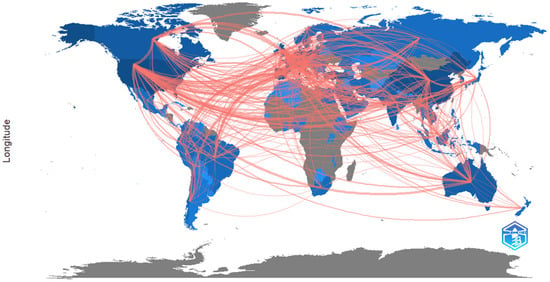
Figure 13.
Country collaboration map.
The author collaboration network is depicted in Figure 14, highlighting frequent collaborations among authors.
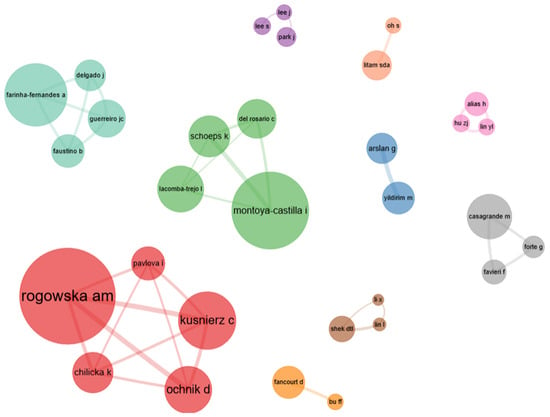
Figure 14.
Top 31 authors collaboration network.
For example, there is a prominent red cluster consisting of Rogowska AM., Kusnierz C., Ochnik D., Chilicka K., and Pavlova I. The size of each circle represents the number of papers written by the author, with larger circles indicating authors who have made significant contributions to the literature. The strength of the edges between authors signifies the intensity of their collaboration.
Figure 14 reveals 10 clusters comprising 31 researchers: (1) the red cluster with 5 researchers, (2) the green cluster with 4 researchers, (3) the turquoise cluster with 4 researchers, (4) the grey cluster with 3 researchers, (5) the pink cluster with 3 researchers, (6) the purple cluster with 3 researchers, (7) the brown cluster with 3 researchers, (8) the blue cluster with 2 researchers, (9) the orange cluster with 2 researchers, and (10) the coral cluster with 2 researchers.
3.4. Analysis of the Literature
The selected papers were analyzed by focusing on the top 10 most cited papers. These top 10 papers are described below, providing information about the number of authors, the countries of the authors, the number of citations, citations per year, and more. Additionally, a brief summary is provided for each paper to offer a better understanding of the research on happiness during the COVID-19 pandemic. In the second part of the literature analysis, the most common words in the papers, as well as frequently occurring words in keywords, bigrams, and trigrams within abstracts and titles, were extracted.
3.4.1. Top 10 Most Cited Papers—Overview
Table 7 presents the top 10 most cited papers considered in this paper, providing various details about these papers. This information includes the primary author’s name, the journal of publication, the number of authors, the publication year, the countries of the authors, and the digital object identifier (DOI). Additional indicators are also included, such as the total number of citations (TC), total citations per year (TCY), and normalized TC (NTC). TCY is calculated by dividing the number of citations by the number of years since the paper was published, and NTC assigns equal credit for citations to all the authors of a cited document [91].

Table 7.
Top 10 most global cited documents.
The paper authored by Ettman et al. [40], published in Jama Network Open, has the highest number of citations, 1122, a TCY value of 280.5, and an NTC of 17.24.
Li et al. [32] rank second in terms of total citations, with 222 citations per year (TCY), followed by Magson et al. [92] with 195 citations per year (TCY).
The top 10 most cited papers in this dataset have received a substantial number of citations, with each paper having over 200 citations. Their times cited per year (TCY) exceed 72.25, and their normalized times cited (NTC) are above 4.44. Given these high citation numbers within the limited set of 1932 papers retrieved using the chosen keywords, it is evident that these top 10 papers have had a significant impact on the literature. On average, there are 4.9 authors per paper, with most having around 4 to 5 authors and only one paper having 8 authors. In terms of author affiliations, the countries represented include Italy (three times), China, the USA, and Australia (twice), along with Turkey, Spain, Germany, Qatar, and Kuwait (each once).
3.4.2. Top 10 Most Cited Papers—Review
A summary of the contents of the papers listed in the top 10 most cited papers is presented below.
Ettman et al. [40]: This highly cited paper conducted two surveys on a population of US adults aged 18 or older. The first survey took place before the COVID-19 pandemic, from 2017 to 2018, while the second was conducted from 31 March 2020, to 13 April 2020. The study used data projections from the COVID-19 and Life Stressors Impact on Mental Health and Well-being study and the National Health and Nutrition Examination Survey. Methodologies included analyzing demographic characteristics, bivariate χ2 analysis, and multivariable logistic regression to assess the correlation between life stressors induced by COVID-19 and symptoms of depression. The analysis was performed using Stata statistical software version 16.1 (StataCorp). The study found an increase in depression symptoms in the United States during the COVID-19 pandemic, with even higher increases observed among groups at higher risk, particularly those with lower socioeconomic status.
Li et al. [32]: The second most cited paper analyzed posts from over 17,000 active Weibo users in China. Using the Online Ecological Recognition (OER) approach, which includes multiple machine learning predictive models, the study assessed the emotional impact of the COVID-19 pandemic. Weibo, a popular social media platform with more than 1.16 million active users, was the data source [95]. The analysis covered posts from 13 January 2020, to 25 January 2020. OER, Text Mind system, Chinese word segmentation tools, and a psychoanalytic dictionary were employed for psychological profile recognition. Statistical analysis was carried out using Statistical Product and Service Solutions 22 (SPSS), including t-tests to compare psychological characteristics before and after the COVID-19 announcement. The results showed an increase in negative emotions such as anxiety and depression after the COVID-19 announcement, coupled with a decrease in life satisfaction and positive emotions.
Magson et al. [92]: This study examined the psychological impact of the COVID-19 pandemic on adolescents during two time periods. The first period covered 12 months before the onset of the COVID-19 outbreak, while the second survey took place two months after the implementation of government restrictions and the shift to online learning. Data were collected from 248 adolescents through online surveys, aiming to study the impact of COVID-19 on their mental health during isolation and online learning. The analysis involved SPSS 26, including t-tests, descriptive statistics, distribution MEMORE macro, correlations, and more. The findings revealed that adolescents expressed more concern about government restrictions to curb the virus’s spread than the virus itself. These concerns were associated with increased anxiety and depressive symptoms and a decrease in life satisfaction.
Satici et al. [44]: Conducted in Turkey, this study explored the relationships between the fear of COVID-19, life satisfaction, and psychological distress. Data were collected from 1304 survey respondents using confirmatory factor analysis, convergent validity, reliability, and Item Response Theory. The results showed a correlation between fear of COVID-19, psychological distress, and life satisfaction.
Maugeri et al. [38]: This study in Italy investigated the impact of physical activity on psychological health during the COVID-19 pandemic. It was an online survey, adapted from the International Physical Activity Questionnaire, and included 2524 valid respondents. A data analysis was conducted using GraphPad Instat® Biostatistics version 3.0 software. The results revealed a significant positive correlation between changes in physical activity and mental well-being.
Casagrande et al. [93]: This study in Italy investigated the impact of physical activity on psychological health during the COVID-19 pandemic. It was an online survey, adapted from the International Physical Activity Questionnaire, and it included 2524 valid respondents. A data analysis was conducted using GraphPad Instat® Biostatistics version 3.0 software. The results revealed a significant positive correlation between changes in physical activity and mental well-being.
Zhang et al. [30]: This was a cross-sectional survey that was conducted on 20–21 February 2020, after one month of restrictions in China. The study aimed to assess life satisfaction, health, and distress among working adults in China during the first month of the COVID-19 outbreak. The results indicated that individuals working in offices had better mental health compared to those working from home or those who had stopped working.
Orgiles et al. [41]: This study examined the emotional effects of the quarantine on children and adolescents in Italy and Spain. A total of 1143 parents of children aged 3 to 18 participated in a survey. A data analysis was performed using SPSS 26 for Mac. The findings revealed that 85.7% of parents observed emotional and behavioral changes in their children during the quarantine. Parents in Spain reported more symptoms than those in Italy, with the most common symptoms including difficulty concentrating, boredom, irritability, restlessness, nervousness, feelings of loneliness, uneasiness, and worries.
Zacher and Rudolph [31]: This study was based in Germany, and it investigated changes in subjective well-being at four time points between December 2019 and May 2020. R software 4.3.2 was used for data analysis. A significant decline in life satisfaction, positive affect, and negative affect was observed between March 2020 and May 2020, coinciding with severe restrictions that limited outdoor activities and an increase in COVID-19 cases. The research demonstrated that, on average, life satisfaction, positive affect, and negative affect declined during the initial phases of the COVID-19 pandemic in Germany.
Abd-Alrazaq et al. [94]: This paper analyzed the primary topics discussed by Twitter users in connection with the COVID-19 pandemic. The study involved the analysis of tweets published in English between 2 February 2020 and 15 March 2020, using various software tools, including the Tweepy Python library, PostgreSQL database, and Twitter’s search application programming interface. The analysis identified four main themes: ways to mitigate the risk of infection, the impact of the virus on people’s lives, the situation in different countries and the economy, and discussions about the origin and sources of the virus.
In Table 8, we observe the first author’s name, publication year, and publishing journal, the paper’s title, a short description of the purpose of the research, the methodology used by researchers, and the data structure or collection. Several bibliometric studies [82,89,96,97] have used the analysis of the top 10 most cited papers as a metric to understand research trends and their impact in the areas of well-being and happiness. These studies demonstrate the value of analyzing the top 10 most cited papers as a metric in bibliometric research, particularly in understanding the impact and trends in the fields of well-being, happiness, and mental health. We consider that the top 10 most cited papers serve as a valuable resource for students, researchers, and practitioners in the field, providing a starting point for understanding the key concepts, theories, and methodologies that have shaped the current state of knowledge.

Table 8.
Brief summary of the content of top 10 most global cited documents.
3.4.3. Words Analysis
The results presented in Table 9 and Table 10 offer insights into the most prevalent concepts employed by researchers in the context of happiness during the COVID-19 pandemic. These concepts are derived from the analysis of abstracts, titles, and keywords. The top 10 keywords, as displayed in Table 8, indicate that the articles are predominantly related to the fields of psychology, the medical domain, and social sciences.

Table 9.
Top 10 most frequent words in keywords plus.

Table 10.
Top 10 most frequent words in authors’ keywords.
These keywords highlight key topics of interest among researchers during the pandemic. Notably, many of these keywords are associated with mental health and emotional well-being.
The top keywords in the given text are related to health and mental well-being. These keywords include “health”, “mental health”, “depression”, “stress”, “anxiety”, “impact”, “satisfaction”, “scale”, “life” and “validation”. It is noteworthy that many of the frequent keywords are not directly associated with positive emotions or concepts like well-being. Instead, they are closer to topics related to fear, pensiveness, or sadness. This suggests that a significant focus of research during the COVID-19 pandemic was on the psychological and emotional challenges faced by individuals, as well as the impact on their mental health.
Table 10 reveals the authors’ keywords and highlights some significant concepts, such as “well-being” (215 occurrences), “life satisfaction” (246 occurrences), and “psychological well-being” (203 occurrences), which, while not the most frequent, are among the top 10. An interesting observation is that terms like “COVID-19” (1067 occurrences) and “COVID-19 pandemic” (146 occurrences) appear exclusively in authors’ keywords and are not present in the frequently used words in keywords plus. Notably, there are common words that appear in both Table 9 and Table 10, including “mental health”, “anxiety”, “depression”, and “stress”.
The top 10 words extracted from titles include “covid_” (1552), “pandemic” (894), “well-being” (601), “psychological” (466), “study” (356), “health” (351), “life” (307), “mental” (267), “satisfaction” (248), and “students” (236). Similarly, the top 10 words extracted from abstracts are “covid_” (5165), “pandemic” (3763), “well-being” (3727), “psychological” (3366), “health” (3158), “study” (2944), “life” (2504), “satisfaction” (2086), “mental” (1950), and “anxiety” (1742). It is worth noting that the most frequent words in titles are also among the most frequent words in abstracts, with slight variations like “students” in titles and “anxiety” in abstracts.
Figure 15 presents a co-occurrence network analysis of the top 50 words, and it illustrates two clusters. Figure 15A represents a cluster of top frequent words in keywords plus, including terms like “health”, “stress”, “mental health”, “depression”, “resilience”, “validation”, “symptoms”, “burnout”, “loneliness”, “prevalence”, “impact”, “satisfaction”, “social support”, “anxiety”, and “depressive symptoms”. Figure 15B focuses more on two central concepts: “COVID-19” and related terms such as “pandemic”, “lockdown”, “coronavirus”, “COVID-19 pandemic”, “SARS-CoV-2”, as well as “well-being” and related words like “mental health”, “subjective well-being”, “life satisfaction”, “quality of life”, “public health”, and “psychological well-being”.
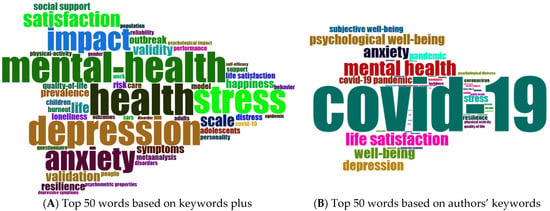
Figure 15.
Top 50 words based on keywords plus (A) and authors’ keywords (B).
Table 11 and Table 12 present the top 10 bigrams and trigrams extracted from titles and abstracts. As expected, “covid_pandemic” is the most prominent bigram in both titles and abstracts, highlighting the association of research with the COVID-19 pandemic. “Psychological well-being” is another frequently occurring bigram. Common bigrams in both analyses include “life satisfaction”, “mental health”, and “subjective well-being”. Two research methods, “online survey” and “cross-sectional study”, are also notable in the bigrams.

Table 11.
Top 10 most frequent bigrams in abstracts and titles.

Table 12.
Top 10 most frequent trigrams in abstracts and titles.
Trigram analysis reveals that “health care workers”, “coronavirus disease covid_”, and “mental health outcomes” are among the top 10 most frequent trigrams present in both titles and abstracts, although in different orders. Notably, there is similarity between trigrams like “coronavirus disease covid_”, “coronavirus disease pandemic”, and “disease covid_ pandemic”. Additionally, “cross-sectional study” and “structural equation modeling” are mentioned in the top trigrams. Certain concepts, such as depression, anxiety, stress, life satisfaction, and “perceived social support”, are more prevalent in abstracts, while titles tend to focus on terms related to COVID-19 and the pandemic period.
3.5. Mixed Analysis
A comprehensive analysis was carried out using three-field plots to enhance the visibility of relationships across various categories, including authors, journals, affiliations, countries, and keywords.
The analysis focused on the top 19 authors, countries, and journals based on the number of papers authored. As expected, Poland emerged as the leading country in terms of the most papers published.
The individual author with the highest number of publications was Rogowska AM, and the journal that published the most papers on this topic was the International Journal of Environmental Research and Public Health. It is evident that authors are distributing their papers across multiple journals rather than exclusively concentrating on one journal.
Figure 16 also underscores the presence of international collaborations in this research field, with authors from various countries showing interest in studying happiness during the COVID-19 pandemic.
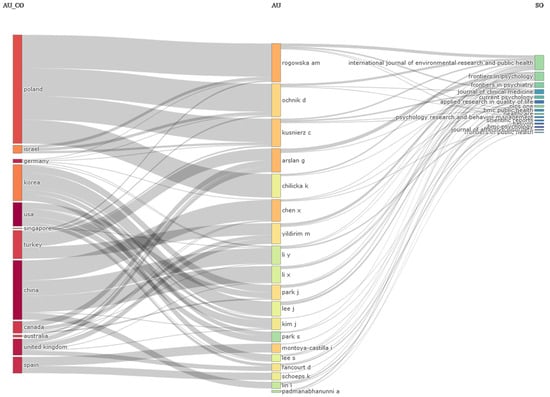
Figure 16.
Three-fields plot: countries (left), authors (middle), and journals (right).
Figure 17 depicts the analysis of affiliations among authors and keywords. The most frequently used word by prominent authors is “COVID-19”.
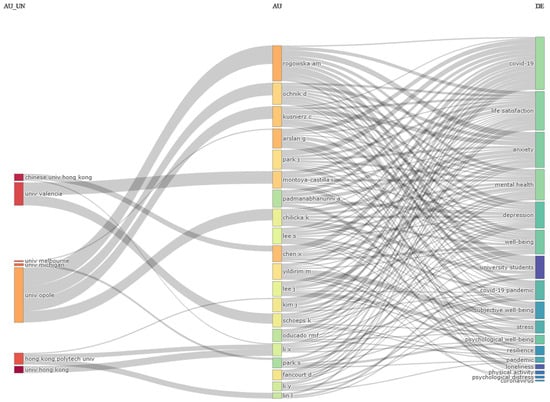
Figure 17.
Three-fields plot: affiliations (left), authors (middle), and keywords (right).
Other frequently used words by these authors pertain to psychology, such as “life satisfaction”, “anxiety”, “mental health”, “depression”, “well-being”, “subjective well-being”, “stress”, “psychological well-being”, “resilience”, “loneliness”, and “psychological distress”.
This emphasis on these psychological aspects indicates the authors’ interest in understanding how individuals felt during the COVID-19 pandemic and how they perceived the restrictions during that time.
Notably, the University of Opole in Poland holds the top position among universities, followed by the University of Valencia.
4. Discussions
The present study employs bibliometric methods to discern significant trends, viewpoints, insights, and perspectives in the domain of happiness during the COVID-19 pandemic. It focuses on key authors and influential research publications, underscoring the abundance of literature dedicated to this subject. To achieve this, a dataset comprising articles on happiness during COVID-19 was gathered and scrutinized from academic databases, including Clarivate Analytics’ Web of Science Core Collection, adhering to predefined filtering criteria in the initial stage. Additionally, the uptick in citations observed in the analysis provides compelling evidence of heightened interest among scholars in this topic throughout the study period, spanning from the onset of the pandemic in 2020 through 2022.
In the bibliometric analysis conducted by Yinka Akintunde et al. [97], it was shown that among the top 10 countries that contributed the most in terms of COVID-19 and mental health research, the USA holds first place, followed by China, Italy, the United Kingdom, Canada, Turkey, India, Spain, Australia, and Brazil. In the current research, the USA also holds first place, but the order and the countries are slightly different, as follows: Italy, China, Germany, Australia, Spain, the United Kingdom, Turkey, Poland, and Canada. The study conducted by Maalouf et al. [98] that compared the number of studies on mental health during COVID-19 with the number of studies during Ebola and H1N1 showed that the top 10 countries by research productivity revealed similar results, with the USA holding first position, followed by the United Kingdom, China, Italy, India, Australia, Canada, Spain, France, and Germany. Regarding international collaborations, the current study showed that there were numerous collaborations between China and the USA, Canada, and Australia. This aspect is also confirmed by the study carried out by Maalouf et al. [98] and Yinka Akintunde et al. [97]. Key word occurrence based on keywords plus showed that words like mental, health, impact, anxiety, outbreak, behavior, COVID-19, physical activity, satisfaction, quality of life, resilience, and outcomes are common aspects in the present study and the bibliometric analysis on effects of COVID-19 on mental health [97].
5. Limitations
The present research suffers from limitations that are primarily due to the dataset selection process. As a series of keywords were used, by enlarging or reducing the keywords used for search, the resulting dataset would have been different to a certain extent. Furthermore, as the keywords search was performed using Clarivate Analytics’ Web of Science Core Collection database, we would like to acknowledge that if other databases had been used, a different set of papers would have been extracted. Also, setting the language of the papers to English produces another limitation of our study, as papers written in other languages were not considered in the dataset. Including papers written in other languages would have altered the structure of the dataset and the obtained results. Another limitation comes from the use of only the “article” type for the papers included in the database. Once again, keeping other types of papers in the analysis, such as conference proceedings or book chapters, would have created a slightly different dataset. Lastly, the timespan limitation imposed on papers published before 2023 further reduces the sample size and limits the results to 2022.
A bibliometric analysis’s purpose is to shape a quantitative analysis of the academic literature, the purpose of which is to establish trends, patterns, and relationships within a specific topic, while a literature review paper designs a qualitative analysis. For further research, a consolidation of a literature review methodology, as the ones presented by Andráško [99] or Jantsch and Veenhhoven [100], and a bibliometric analysis could create a valuable resource for researchers who plan to study happiness and well-being before COVID-19, during COVID-19, and in the first few years after the pandemic period.
However, future analyses may consider updating the dataset to include more recent data if deemed appropriate and necessary, considering the potential implications for citation indicators and the overall validity of the findings.
6. Conclusions
The present paper analyzes the scientific production related to happiness and COVID-19 through the use of a dataset extracted from Clarivate Analytics’ Web of Science Core Collection based on selected keywords and a bibliometric analysis, followed by a review of the top-10 most cited papers.
As a result, it has been observed that papers on tracking happiness during the COVID-19 pandemic have seen a significant increase in numbers since the onset of the disease. Researchers have focused on studying mental health, psychological well-being, subjective well-being, and life satisfaction during this period, as indicated by bigrams analysis. Online surveys emerged as the most commonly used method for data collection, likely driven by the shift to online activities during the pandemic.
Regarding international collaborations, the data analysis revealed that China had 51 collaborations with the USA, while the USA had 24 collaborations with the United Kingdom. Among authors, Rogowska AM from the University of Opole in Poland stands out as the most prolific contributor to this topic between 2020 and 2022, followed by Arslan G from Mehmet Akif Ersoy University.
In terms of journals, the top five most relevant sources for research on this subject include the International Journal of Environmental Research and Public Health, Frontiers in Psychology, PLOS ONE, Frontiers in Psychiatry, and Sustainability.
Regarding the top 10 most cited papers, it has been observed that the focus has mainly been on the psychological impacts of the COVID-19 pandemic, emphasizing the importance of addressing mental health concerns and implementing strategies to support well-being during and after such crises. According to Magson et al. [92], adolescents were most distressed about not being able to see their friends during the COVID-19 pandemic, followed by concerns about friends or family members contracting and becoming severely ill or dying from COVID-19. Researchers found that the rate of depression symptoms in the United States was over three times higher during the COVID-19 pandemic period compared to before the pandemic [40], while in China, after the declaration of COVID-19, negative emotions like anxiety, depression, or indignation increased among the population and life satisfaction and positive emotions decreased [32]. Psychological well-being has been negatively impacted by the reduction of physical activity during lockdown [38]. A significant relationship between sleep quality, psychological distress, and generalized anxiety with COVID-19 was also highlighted in the study of Casagrande et al. [93], which stated that “The enemy who sealed the world: Effects quarantine due to the COVID-19 on sleep quality, anxiety, and psychological distress in the Italian population”.
This bibliometric analysis highlights the relevance and growth of the well-being topic over time, especially during COVID-19. This study showcases the countries and institutions that have contributed to happiness research and may be considered a starting point for other researchers for a deeper literature review on subjective well-being during and after COVID-19. The H-index analysis, which provides valuable data about the impact of publications on happiness and the distribution of publications across various journals, offers valuable insights for other researchers intending to publish papers on this topic regarding the most relevant journals in the field study.
In conclusion, the COVID-19 pandemic has significantly impacted people’s lives and daily routines over a relatively short period of time. This includes a decrease in overall well-being and happiness levels, as well as a notable rise in negative emotions, sleep issues, and reduced physical activity.
Additional analysis could delve into country-specific papers and track the analyses related to happiness in the context of COVID-19. Such an approach would allow for a comparison of the results observed for each country and their connection with country-specific characteristics and annually reported indices.
Author Contributions
Conceptualization, A.-I.J., C.D., M.-S.F. and L.-A.C.; Data curation, A.-I.J.; Formal analysis, A.-I.J. and C.D.; Investigation, A.-I.J., M.-S.F. and L.-A.C.; Methodology, A.-I.J. and C.D.; Resources, A.-I.J.; Software, A.-I.J. and L.-A.C.; Supervision, C.D.; Validation, A.-I.J., C.D. and M.-S.F.; Visualization, A.-I.J., C.D., M.-S.F. and L.-A.C.; Writing—original draft, A.-I.J.; Writing—review and editing, C.D., M.-S.F. and L.-A.C. All authors have read and agreed to the published version of the manuscript.
Funding
This research received no external funding.
Institutional Review Board Statement
Not applicable.
Informed Consent Statement
Not applicable.
Data Availability Statement
Data are contained within the article.
Acknowledgments
The work is supported by a grant of the Romanian Ministry of Research and Innovation, project CNFIS-FDI-2024-0302—‘Development adaptation of collaborative processes in excellence research conducted at BUES, in the context of modern challenges brought by Open Science and Artificial Intelligence (eXROS)”, and by a grant of the Romanian Ministry of Research and Innovation, project 42PFE/30.12.2021—‘Increasing institutional performance through the development of the infrastructure and research ecosystem of transdisciplinary excellence in the socio-economic field’ (PERFECTIS).
Conflicts of Interest
The authors declare no conflicts of interest.
References
- Kringelbach, M.L.; Berridge, K.C. The Neuroscience of Happiness and Pleasure. Soc. Res. 2010, 77, 659–678. [Google Scholar] [CrossRef]
- Ami̇rzai̇, F.R.; Sönmez, A. Socio-Economic Determinants of Happiness: The Case of Afghanistan. Sosyoekonomi 2022, 30, 183–198. [Google Scholar] [CrossRef]
- Diener, E.; Suh, E.M.; Lucas, R.E.; Smith, H.L. Subjective Well-Being: Three Decades of Progress. Psychol. Bull. 1999, 125, 276–302. [Google Scholar] [CrossRef]
- Kahneman, D.; Diener, E.; Schwarz, N. (Eds.) Well-Being: The Foundations of Hedonic Psychology; Russell Sage Foundation: Manhattan, NY, USA, 1999. [Google Scholar]
- Veenhoven, R. Conditions of Happiness; Springer: Dordrecht, The Netherlands, 1984; ISBN 978-94-009-6434-1. [Google Scholar]
- Moeinaddini, M.; Asadi-Shekari, Z.; Aghaabbasi, M.; Saadi, I.; Zaly Shah, M.; Cools, M. Proposing a New Score to Measure Personal Happiness by Identifying the Contributing Factors. Measurement 2020, 151, 107115. [Google Scholar] [CrossRef]
- Ronald, I. World Values Surveys and European Values Surveys, 1981–1984, 1990–1993, and 1995–1997. 2000. Available online: http://web.stanford.edu/group/ssds/dewidocs/icpsr2790/cb2790.pdf (accessed on 27 May 2024).
- Ahrendt, D.; Dubois, H.; Mezger, E. An Overview of Quality of Life in Europe. In Global Handbook of Quality of Life: Exploration of Well-Being of Nations and Continents; Glatzer, W., Camfield, L., Møller, V., Rojas, M., Eds.; International Handbooks of Quality-of-Life; Springer: Dordrecht, The Netherlands, 2015; pp. 625–661. ISBN 978-94-017-9178-6. [Google Scholar]
- Kristapsone, S.; Bruna, S. Changes in the Subjective Assessment of Quality of Life in Latvia and the European Union: Results of European Quality of Life Survey 2016; University of Latvia: Rīga, Latvia, 2019; ISBN 978-9934-18-428-4. [Google Scholar]
- Piper, A.T. Europe’s Capital Cities and the Happiness Penalty: An Investigation Using the European Social Survey. Soc. Indic. Res. 2015, 123, 103–126. [Google Scholar] [CrossRef]
- Powdthavee, N.; Burkhauser, R.V.; De Neve, J.-E. Top Incomes and Human Well-Being: Evidence from the Gallup World Poll. J. Econ. Psychol. 2017, 62, 246–257. [Google Scholar] [CrossRef]
- Xia, X.; Yu, Y.; Zou, Y. Air Pollution, Social Engagement and Subjective Well-Being: Evidence from the Gallup World Poll. Environ. Sci. Pollut. Res. 2022, 29, 52033–52056. [Google Scholar] [CrossRef]
- Joshanloo, M.; Jovanović, V. Subjective Health in Relation to Hedonic and Eudaimonic Wellbeing: Evidence from the Gallup World Poll. J. Health Psychol. 2021, 26, 438–448. [Google Scholar] [CrossRef] [PubMed]
- Diener, E.; Tay, L. Subjective Well-Being and Human Welfare around the World as Reflected in the Gallup World Poll. Int. J. Psychol. 2015, 50, 135–149. [Google Scholar] [CrossRef]
- Salameh, A.A.; Amin, S.; Danish, M.H.; Asghar, N.; Naveed, R.T.; Munir, M. Socio-Economic Determinants of Subjective Wellbeing toward Sustainable Development Goals: An Insight from a Developing Country. Front. Psychol. 2022, 13, 961400. [Google Scholar] [CrossRef]
- Happiness Should Have Greater Role in Development Policy–UN Member States|UN News. Available online: https://news.un.org/en/story/2011/07/382052 (accessed on 27 May 2024).
- O’Brien, C. Sustainable Happiness and Well-Being: Future Directions for Positive Psychology. Psychology 2012, 03, 1196–1201. [Google Scholar] [CrossRef]
- Sustainable Development and Human Well-Being. Available online: https://worldhappiness.report/ed/2020/sustainable-development-and-human-well-being/ (accessed on 27 May 2024).
- Cloutier, S.; Pfeiffer, D. Sustainability Through Happiness: A Framework for Sustainable Development. Sustain. Dev. 2015, 23, 317–327. [Google Scholar] [CrossRef]
- THE 17 GOALS|Sustainable Development. Available online: https://sdgs.un.org/goals (accessed on 27 May 2024).
- Home. Available online: https://worldhappiness.report/ (accessed on 27 May 2024).
- Helliwell, J.F.; Layard, R.; Sachs, J.D.; Neve, J.-E.D. World Happiness Report 2020. Available online: https://worldhappiness.report/ed/2020/ (accessed on 27 May 2024).
- O’Brien, C. Happiness and Sustainability Together at Last! Sustainable Happiness. Can. J. Educ. /Rev. Can. De L'éducation 2013, 36, 228–256. [Google Scholar]
- The Team behind the Happy Planet Index–Happy Planet Index. Available online: https://happyplanetindex.org/learn-about-the-happy-planet-index/ (accessed on 9 January 2024).
- Li, Q.; Guan, X.; Wu, P.; Wang, X.; Zhou, L.; Tong, Y.; Ren, R.; Leung, K.S.M.; Lau, E.H.Y.; Wong, J.Y.; et al. Early Transmission Dynamics in Wuhan, China, of Novel Coronavirus-Infected Pneumonia. N. Engl. J. Med. 2020, 382, 1199–1207. [Google Scholar] [CrossRef]
- Rana, R.; Tripathi, A.; Kumar, N.; Ganguly, N.K. A Comprehensive Overview on COVID-19: Future Perspectives. Front. Cell. Infect. Microbiol. 2021, 11, 744903. [Google Scholar] [CrossRef]
- Fan, J.; Gao, Y.; Zhao, N.; Dai, R.; Zhang, H.; Feng, X.; Shi, G.; Tian, J.; Chen, C.; Hambly, B.D.; et al. Bibliometric Analysis on COVID-19: A Comparison of Research Between English and Chinese Studies. Front. Public Health 2020, 8, 477. [Google Scholar] [CrossRef] [PubMed]
- Shen, X.; Yan, S.; Cao, H.; Feng, J.; Lei, Z.; Zhang, W.; Lv, C.; Gan, Y. Current Status and Associated Factors of Depression and Anxiety Among the Chinese Residents During the Period of Low Transmission of COVID-19. Front. Psychol. 2021, 12, 700376. [Google Scholar] [CrossRef]
- Xiong, J.; Lipsitz, O.; Nasri, F.; Lui, L.M.W.; Gill, H.; Phan, L.; Chen-Li, D.; Iacobucci, M.; Ho, R.; Majeed, A.; et al. Impact of COVID-19 Pandemic on Mental Health in the General Population: A Systematic Review. J. Affect. Disord. 2020, 277, 55–64. [Google Scholar] [CrossRef] [PubMed]
- Zhang, S.X.; Wang, Y.; Rauch, A.; Wei, F. Unprecedented Disruption of Lives and Work: Health, Distress and Life Satisfaction of Working Adults in China One Month into the COVID-19 Outbreak. Psychiatry Res. 2020, 288, 112958. [Google Scholar] [CrossRef]
- Zacher, H.; Rudolph, C.W. Individual Differences and Changes in Subjective Wellbeing during the Early Stages of the COVID-19 Pandemic. Am. Psychol. 2021, 76, 50–62. [Google Scholar] [CrossRef]
- Li, S.; Wang, Y.; Xue, J.; Zhao, N.; Zhu, T. The Impact of COVID-19 Epidemic Declaration on Psychological Consequences: A Study on Active Weibo Users. Int. J. Environ. Res. Public Health 2020, 17, 2032. [Google Scholar] [CrossRef] [PubMed]
- Jahrami, H.; BaHammam, A.S.; Bragazzi, N.L.; Saif, Z.; Faris, M.; Vitiello, M.V. Sleep Problems during the COVID-19 Pandemic by Population: A Systematic Review and Meta-Analysis. J. Clin. Sleep Med. 2021, 17, 299–313. [Google Scholar] [CrossRef] [PubMed]
- Altena, E.; Baglioni, C.; Espie, C.A.; Ellis, J.; Gavriloff, D.; Holzinger, B.; Schlarb, A.; Frase, L.; Jernelöv, S.; Riemann, D. Dealing with Sleep Problems during Home Confinement Due to the COVID-19 Outbreak: Practical Recommendations from a Task Force of the European CBT-I Academy. J. Sleep Res. 2020, 29, e13052. [Google Scholar] [CrossRef]
- Jiang, Z.; Zhu, P.; Wang, L.; Hu, Y.; Pang, M.; Ma, S.; Tang, X. Psychological Distress and Sleep Quality of COVID-19 Patients in Wuhan, a Lockdown City as the Epicenter of COVID-19. J. Psychiatr. Res. 2021, 136, 595–602. [Google Scholar] [CrossRef]
- Pang, J.C.Y.; Chan, E.L.S.; Lau, H.M.C.; Reeves, K.K.L.; Chung, T.H.Y.; Hui, H.W.L.; Leung, A.H.L.; Fu, A.C.L. The Impacts of Physical Activity on Psychological and Behavioral Problems, and Changes in Physical Activity, Sleep and Quality of Life during the COVID-19 Pandemic in Preschoolers, Children, and Adolescents: A Systematic Review and Meta-Analysis. Front. Pediatr. 2023, 11, 1015943. [Google Scholar] [CrossRef] [PubMed]
- Shaik, L.; Boike, S.; Ramar, K.; Subramanian, S.; Surani, S. COVID-19 and Sleep Disturbances: A Literature Review of Clinical Evidence. Medicina 2023, 59, 818. [Google Scholar] [CrossRef] [PubMed]
- Maugeri, G.; Castrogiovanni, P.; Battaglia, G.; Pippi, R.; D’Agata, V.; Palma, A.; Rosa, M.; Musumeci, G. The Impact of Physical Activity on Psychological Health during Covid-19 Pandemic in Italy. Heliyon 2020, 6, e04315. [Google Scholar] [CrossRef] [PubMed]
- Mason, M.R.; Hudgins, J.H.; Campbell, M.S.; Biddle, M.J.; Ickes, M.J.; Dugan, A.; Bollinger, L.M. Changes in Physical Activity during the Initial Stages of the COVID-19 Pandemic. J. Sports Sci. 2022, 40, 116–124. [Google Scholar] [CrossRef] [PubMed]
- Ettman, C.K.; Abdalla, S.M.; Cohen, G.H.; Sampson, L.; Vivier, P.M.; Galea, S. Prevalence of Depression Symptoms in US Adults Before and During the COVID-19 Pandemic. JAMA Netw. Open 2020, 3, e2019686. [Google Scholar] [CrossRef]
- Orgilés, M.; Morales, A.; Delvecchio, E.; Mazzeschi, C.; Espada, J.P. Immediate Psychological Effects of the COVID-19 Quarantine in Youth From Italy and Spain. Front. Psychol. 2020, 11, 579038. [Google Scholar] [CrossRef]
- Prati, G.; Mancini, A.D. Happiness before and during the COVID-19 Pandemic in Italy: A Population-Based Longitudinal Study. Int. J. Disaster Risk Reduct. 2023, 91, 103711. [Google Scholar] [CrossRef] [PubMed]
- Bimonte, S.; Bosco, L.; Stabile, A. In Virus Veritas Lockdown and Happiness Under COVID-19. Soc. Indic. Res. 2022, 164, 823–842. [Google Scholar] [CrossRef] [PubMed]
- Satici, B.; Göçet Tekin, E.; Deniz, M.; Satici, S.A. Adaptation of the Fear of COVID-19 Scale: Its Association with Psychological Distress and Life Satisfaction in Turkey. Int. J. Ment. Health Addict. 2021, 19, 1980–1988. [Google Scholar] [CrossRef] [PubMed]
- Delhey, J.; Hess, S.; Boehnke, K.; Deutsch, F.; Eichhorn, J.; Kühnen, U.; Welzel, C. Life Satisfaction During the COVID-19 Pandemic: The Role of Human, Economic, Social, and Psychological Capital. J. Happiness Stud. 2023, 24, 2201–2222. [Google Scholar] [CrossRef]
- Author Search-Web of Science Core Collection. Available online: https://www.webofscience.com/wos/author/search (accessed on 18 October 2023).
- Dominko, M.; Verbič, M. The Economics of Subjective Well-Being: A Bibliometric Analysis. J. Happiness Stud. 2019, 20, 1973–1994. [Google Scholar] [CrossRef]
- Angner, E. Is It Possible to Measure Happiness?: The Argument from Measurability. Eur. J. Philos. Sci. 2013, 3, 221–240. [Google Scholar] [CrossRef]
- Ng, Y.-K. Happiness—Concept, Measurement and Promotion; Springer Nature: Singapore, 2022; ISBN 978-981-334-971-1. [Google Scholar]
- Das, K.V.; Jones-Harrell, C.; Fan, Y.; Ramaswami, A.; Orlove, B.; Botchwey, N. Understanding Subjective Well-Being: Perspectives from Psychology and Public Health. Public Health Rev. 2020, 41, 25. [Google Scholar] [CrossRef] [PubMed]
- Lang, J. The Most Influential Factors in Determining the Happiness of Nations. Major Themes Econ. 2012, 14, 33–54. [Google Scholar]
- Thinley, J.Y.; Hartz-Karp, J. National Progress, Sustainability and Higher Goals: The Case of Bhutan’s Gross National Happiness. Sustain. Earth 2019, 2, 11. [Google Scholar] [CrossRef]
- Ejaz, H.; Zeeshan, H.M.; Ahmad, F.; Bukhari, S.N.A.; Anwar, N.; Alanazi, A.; Sadiq, A.; Junaid, K.; Atif, M.; Abosalif, K.O.A.; et al. Bibliometric Analysis of Publications on the Omicron Variant from 2020 to 2022 in the Scopus Database Using R and VOSviewer. Int. J. Environ. Res. Public Health 2022, 19, 12407. [Google Scholar] [CrossRef]
- Donthu, N.; Kumar, S.; Mukherjee, D.; Pandey, N.; Lim, W.M. How to Conduct a Bibliometric Analysis: An Overview and Guidelines. J. Bus. Res. 2021, 133, 285–296. [Google Scholar] [CrossRef]
- Marín-Rodríguez, N.J.; González-Ruiz, J.D.; Valencia-Arias, A. Incorporating Green Bonds into Portfolio Investments: Recent Trends and Further Research. Sustainability 2023, 15, 14897. [Google Scholar] [CrossRef]
- Anaç, M.; Gumusburun Ayalp, G.; Erdayandi, K. Prefabricated Construction Risks: A Holistic Exploration through Advanced Bibliometric Tool and Content Analysis. Sustainability 2023, 15, 11916. [Google Scholar] [CrossRef]
- AlRyalat, S.A.S.; Malkawi, L.W.; Momani, S.M. Comparing Bibliometric Analysis Using PubMed, Scopus, and Web of Science Databases. J. Vis. Exp. 2019, 152, e58494. [Google Scholar] [CrossRef] [PubMed]
- Popescu, D.; Dima, A.; Radu, E.; Dobrota, E.M.; Dumitrache, V.-M. Bibliometric Analysis of the Green Deal Policies in the Food Chain. Amfiteatru Econ. J. 2022, 24, 410. [Google Scholar] [CrossRef]
- Liu, W. The Data Source of This Study Is Web of Science Core Collection? Not Enough. Scientometrics 2019, 121, 1815–1824. [Google Scholar] [CrossRef]
- Liu, F. Retrieval Strategy and Possible Explanations for the Abnormal Growth of Research Publications: Re-Evaluating a Bibliometric Analysis of Climate Change. Scientometrics 2023, 128, 853–859. [Google Scholar] [CrossRef]
- El-Krab, R.; Kalichman, S.; Govindasamy, D.; Banas, E.; Kalichman, M.; Mathews, C. Subjective Well-Being and COVID-19 Prevention Practices among People Living with HIV in Cape Town, South Africa. Glob. Public Health 2022, 17, 1–12. [Google Scholar] [CrossRef]
- Randall, K.; Ford, T.G.; Kwon, K.-A.; Sisson, S.S.; Bice, M.R.; Dinkel, D.; Tsotsoros, J. Physical Activity, Physical Well-Being, and Psychological Well-Being: Associations with Life Satisfaction during the COVID-19 Pandemic among Early Childhood Educators. Int. J. Environ. Res. Public Health 2021, 18, 9430. [Google Scholar] [CrossRef]
- Budak, F.; Özer, Ö.; Özkan, O. Investigation of COVID-19 Risk Perception and Psychological Well-Being in Syrian Refugees. Smith Coll. Stud. Soc. Work. 2021, 91, 309–323. [Google Scholar] [CrossRef]
- İme, Y.; Ümmet, D. Adaptation of Emotional Flexibility Scale: Its Association with Subjective Well Being and Resilience During Covid-19 Pandemic. Child Indic. Res. 2022, 15, 2141–2154. [Google Scholar] [CrossRef]
- Wen, F.; Ye, H.; Zuo, B.; Han, S.; Zhu, J.; Ke, W.; He, Y. The Association between Insecurity and Subjective Well-Being among Youth during the COVID-19 Outbreak: A Moderated Mediation Model. J. Affect. Disord. 2022, 297, 486–494. [Google Scholar] [CrossRef] [PubMed]
- Engel de Abreu, P.M.J.; Neumann, S.; Wealer, C.; Abreu, N.; Coutinho Macedo, E.; Kirsch, C. Subjective Well-Being of Adolescents in Luxembourg, Germany, and Brazil During the COVID-19 Pandemic. J. Adolesc. Health 2021, 69, 211–218. [Google Scholar] [CrossRef]
- Anglim, J.; Horwood, S. Effect of the COVID-19 Pandemic and Big Five Personality on Subjective and Psychological Well-Being. Soc. Psychol. Personal. Sci. 2021, 12, 1527–1537. [Google Scholar] [CrossRef]
- Delsignore, G.; Aguilar-Latorre, A.; Oliván-Blázquez, B. Measuring Happiness in the Social Sciences: An Overview. J. Sociol. 2021, 57, 1044–1067. [Google Scholar] [CrossRef]
- Balasubramanian, S.; Cashin, P. Gross National Happiness and Macroeconomic Indicators in the Kingdom of Bhutan. IMF Work. Pap. 2019, 2019. [Google Scholar] [CrossRef]
- Stone, A.A.; Mackie, C.; Framework, P. National Research Council. Introduction. In Subjective Well-Being: Measuring Happiness, Suffering, and Other Dimensions of Experience [Internet]; National Academies Press (US): Washington, DC, USA, 2013. [Google Scholar]
- Larsen, R.J.; Diener, E.; Emmons, R.A. An Evaluation of Subjective Well-Being Measures. Soc. Indic. Res. 1985, 17, 1–17. [Google Scholar] [CrossRef]
- IPSOS. Global Happiness 2022: What Makes People Happy in the Age of COVID-19? IPSOS, Paris. 2022. Available online: www.ipsos.com/en-uk/what-makes-people-happiest-health-family-and-purpose (accessed on 9 January 2024).
- Aria, M.; Cuccurullo, C. Bibliometrix: An R-Tool for Comprehensive Science Mapping Analysis. J. Informetr. 2017, 11, 959–975. [Google Scholar] [CrossRef]
- Delcea, C.; Cotfas, L.-A. State of the Art in Grey Systems Research in Economics and Social Sciences. In Advancements of Grey Systems Theory in Economics and Social Sciences; Series on Grey System; Springer Nature: Singapore, 2023; pp. 1–44. ISBN 978-981-19993-1-4. [Google Scholar]
- Zardari, S.; Alam, S.; Al Salem, H.A.; Al Reshan, M.S.; Shaikh, A.; Malik, A.F.K.; Masood Ur Rehman, M.; Mouratidis, H. A Comprehensive Bibliometric Assessment on Software Testing (2016–2021). Electronics 2022, 11, 1984. [Google Scholar] [CrossRef]
- Marín-Rodríguez, N.J.; González-Ruiz, J.D.; Botero Botero, S. Dynamic Co-Movements among Oil Prices and Financial Assets: A Scientometric Analysis. Sustainability 2022, 14, 12796. [Google Scholar] [CrossRef]
- Delcea, C.; Javed, S.A.; Florescu, M.-S.; Ioanas, C.; Cotfas, L.-A. 35 Years of Grey System Theory in Economics and Education. Kybernetes 2023. [Google Scholar] [CrossRef]
- Madsen, D.Ø.; Berg, T.; Di Nardo, M. Bibliometric Trends in Industry 5.0 Research: An Updated Overview. ASI 2023, 6, 63. [Google Scholar] [CrossRef]
- Gorski, A.-T.; Ranf, E.-D.; Badea, D.; Halmaghi, E.-E.; Gorski, H. Education for Sustainability—Some Bibliometric Insights. Sustainability 2023, 15, 14916. [Google Scholar] [CrossRef]
- Castillo-Vergara, M.; Muñoz-Cisterna, V.; Geldes, C.; Álvarez-Marín, A.; Soto-Marquez, M. Bibliometric Analysis of Computational and Mathematical Models of Innovation and Technology in Business. Axioms 2023, 12, 631. [Google Scholar] [CrossRef]
- López-Fernández, M.C.; Serrano-Bedia, A.M.; Pérez-Pérez, M. Entrepreneurship and Family Firm Research: A Bibliometric Analysis of An Emerging Field. J. Small Bus. Manag. 2016, 54, 622–639. [Google Scholar] [CrossRef]
- Pang, N.T.P.; Kamu, A.; Guan, T.E.; Sombuling, A.; Ho, C.M.; Mohamad, N.H.; Wider, W.; Fauzi, M.A. Happiness and Satisfaction Research Pre and during the COVID-19 Pandemic: A Bibliometric Analysis of Global Scientific Literature. F1000Research 2023, 12, 658. [Google Scholar] [CrossRef]
- Aria, M.; Cuccurullo, C. A Brief Introduction to Bibliometrix. Available online: https://www.bibliometrix.org/vignettes/Introduction_to_bibliometrix.html (accessed on 22 November 2023).
- Viju, V.G.W. Application of Bradford’s Law of Scattering to the Literature of Library & Information Science: A Study of Doctoral Theses Citations Submitted to the Universities of Maharashtra, India. Libr. Philos. Pract. 2013, 15, 1–45. [Google Scholar]
- Shah, F.A.; Jawaid, S.A. The H-Index: An Indicator of Research and Publication Output. Pak. J. Med. Sci. 2023, 39, 315–316. [Google Scholar] [CrossRef] [PubMed]
- Koltun, V.; Hafner, D. The H-Index Is No Longer an Effective Correlate of Scientific Reputation. PLoS ONE 2021, 16, e0253397. [Google Scholar] [CrossRef] [PubMed]
- Memon, A.R.; Chen, S.; To, Q.G.; Vandelanotte, C. Vigorously Cited: A Bibliometric Analysis of the 100 Most Cited Sedentary Behaviour Articles. J. Act. Sedentary Sleep Behav. 2023, 2, 13. [Google Scholar] [CrossRef]
- Yu, Q.; Tan, S.; Ren, Y.; He, M.; Fu, X.; Peng, Y.; Tang, X. Bibliometric Analysis of the 100 Most-Cited Articles in the Field of Hepatology. Gastroenterol. Hepatol. 2020, 43, 349–357. [Google Scholar] [CrossRef] [PubMed]
- Yiğit, B.; Çakmak, B.Y. Discovering Psychological Well-Being: A Bibliometric Review. J. Happiness Stud. 2024, 25, 43. [Google Scholar] [CrossRef]
- Bülbül, A.E. Bibliometric Analysis of Studies on Well-Being. J. Educ. Teach. Train. 2023, 14, 223–233. [Google Scholar] [CrossRef]
- Bornmann, L.; Marx, W. Methods for the Generation of Normalized Citation Impact Scores in Bibliometrics: Which Method Best Reflects the Judgements of Experts? J. Informetr. 2015, 9, 408–418. [Google Scholar] [CrossRef]
- Magson, N.R.; Freeman, J.Y.A.; Rapee, R.M.; Richardson, C.E.; Oar, E.L.; Fardouly, J. Risk and Protective Factors for Prospective Changes in Adolescent Mental Health during the COVID-19 Pandemic. J. Youth Adolesc. 2021, 50, 44–57. [Google Scholar] [CrossRef] [PubMed]
- Casagrande, M.; Favieri, F.; Tambelli, R.; Forte, G. The Enemy Who Sealed the World: Effects Quarantine Due to the COVID-19 on Sleep Quality, Anxiety, and Psychological Distress in the Italian Population. Sleep Med. 2020, 75, 12–20. [Google Scholar] [CrossRef] [PubMed]
- Abd-Alrazaq, A.; Alhuwail, D.; Househ, M.; Hamdi, M.; Shah, Z. Top Concerns of Tweeters During the COVID-19 Pandemic: Infoveillance Study. J. Med. Internet Res. 2020, 22, e19016. [Google Scholar] [CrossRef] [PubMed]
- Che, X.; Ip, B. Social Networks in China; Chandos Publishing: Hull, UK, 2017; ISBN 978-0-08-101935-1. [Google Scholar]
- Wang, F.; Guo, J.; Yang, G. Study on Positive Psychology from 1999 to 2021: A Bibliometric Analysis. Front. Psychol. 2023, 14, 1101157. [Google Scholar] [CrossRef] [PubMed]
- Akintunde, T.Y.; Musa, T.H.; Musa, H.H.; Musa, I.H.; Chen, S.; Ibrahim, E.; Tassang, A.E.; Helmy, M.S.E.D.M. Bibliometric Analysis of Global Scientific Literature on Effects of COVID-19 Pandemic on Mental Health. Asian J. Psychiatry 2021, 63, 102753. [Google Scholar] [CrossRef]
- Maalouf, F.T.; Mdawar, B.; Meho, L.I.; Akl, E.A. Mental Health Research in Response to the COVID-19, Ebola, and H1N1 Outbreaks: A Comparative Bibliometric Analysis. J. Psychiatr. Res. 2021, 132, 198–206. [Google Scholar] [CrossRef]
- Andráško, I. Why People (Do Not) Adopt the Private Precautionary and Mitigation Measures: A Review of the Issue from the Perspective of Recent Flood Risk Research. Water 2021, 13, 140. [Google Scholar] [CrossRef]
- Jantsch, A.; Veenhoven, R. Happiness and Wealth: A Literature Review Using an Online Findings Archive. Glob. J. Hum. -Soc. Sci. 2022, 22, 25–68. [Google Scholar] [CrossRef]
Disclaimer/Publisher’s Note: The statements, opinions and data contained in all publications are solely those of the individual author(s) and contributor(s) and not of MDPI and/or the editor(s). MDPI and/or the editor(s) disclaim responsibility for any injury to people or property resulting from any ideas, methods, instructions or products referred to in the content. |
© 2024 by the authors. Licensee MDPI, Basel, Switzerland. This article is an open access article distributed under the terms and conditions of the Creative Commons Attribution (CC BY) license (https://creativecommons.org/licenses/by/4.0/).